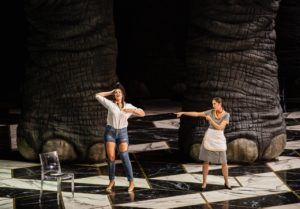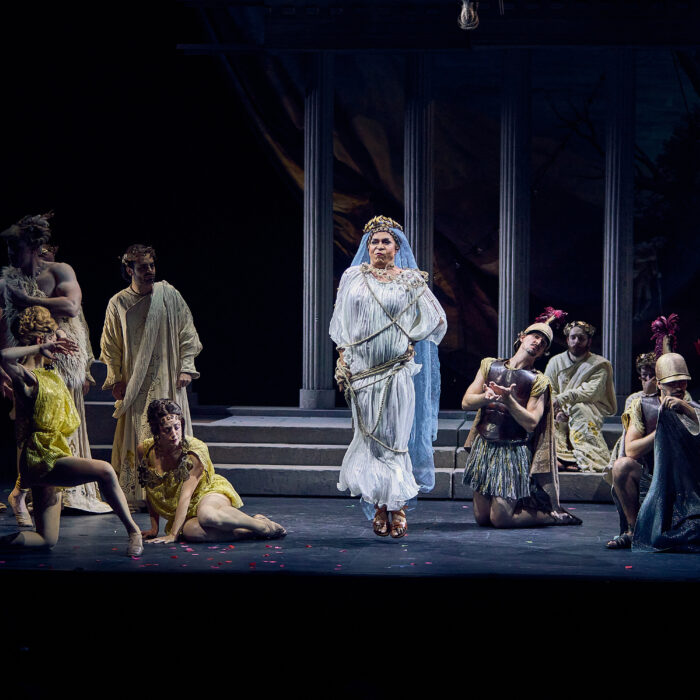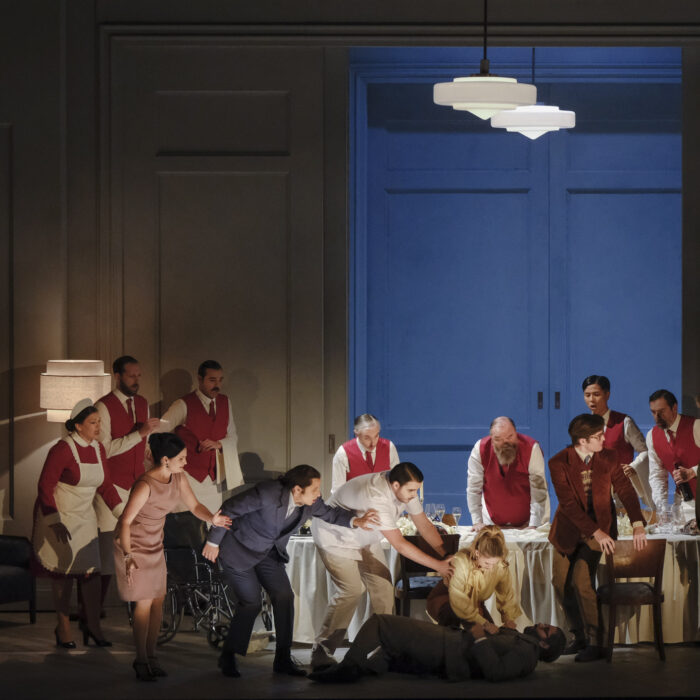
Teatro dell’Opera di Roma 2018-19 Review: Le Nozze di Figaro
Music Genius Abounds, But Graham Vick’s Overzealous Vision Is The Elephant In the Room
By Alan NeilsonAct two of “Le Nozze di Figaro” opens in a modern living room with sleekly designed furniture, surrounding a polar bear skin rug. On the back wall is a very large picture of an elephant crashing into the room.
By Act three the same elephant is now standing inside the room. It has grown substantially. It is now a giant elephant, only its legs are visible. As the old expression runs, there is an elephant in the room!
Mozart For the Modern
For this production of “Le Nozze di Figaro” for Opera Roma, Graham Vick, the British director decided to update Mozart and Da Ponte’s famous work to the present day in an attempt to be relevant for a modern-day audience.
Itself based on Beaumarchais’ play, the work took aim at the abuses of the ancient régime, as symbolized in this case by the “droit du seigneur,” which gave the local Lord the right to have sex with any woman he chose the night before her wedding day. Although it had long since fallen into disuse, Count Almaviva still feels he has the moral authority to exert this ancient right. Figaro and Susanna, however, manage to outwit the Count, when he decides to turn his attention towards Susanna.
It is a work founded upon the ideas of the enlightenment, of equality, liberty and fraternity. Yet, more than 200 years later has anything fundamentally changed? As the gulf between the rich and poor increases year on year, we have seen the return of slavery and quasi-slavery to Western society, with the rich exploiting their position over the poor to enforce them into, not just accepting poverty wages, but also offering sexual favors and giving up certain aspects of their liberty.
Of course, the perpetrators of such actions maintain an upstanding and congenial public face, and readily virtue signal to the world, while indulging in their private menaces. So widespread has this behavior become that the UK parliament has had to a pass law against such abuses, but of course, it is very difficult to enforce.
Such is Vick’s starting point for this production.
The Elephant In the Room
Count Almaviva and his wife are members of the super rich, with a large retinue of servants, who are forced to work hard for their small wages. During the overture we watch as the servants, on their hands and knees, scrubbing the floor. Susanna and Figaro are two of his more senior servants. And so the drama unfolds as in the original.
However, Vick decided to exaggerate one aspect of his interpretation, that is the role of sexual exploitation, but in its many forms, so that all its characters become highly sexualized, either as objects for someone’s gratification or as abusers. With the #Metoo movement and the many women, and to a lesser extent, men coming forward to denounce their abusers, the relevance of Vick’s interpretation, and arguably of Mozart’s work, to the present day is clear.
Unfortunately, and typical of a Graham Vick production, he takes the idea too far, so that by Act four we have semi-naked women nailed to the walls in the garden, and a naked dead woman’s body dumped in a wheelbarrow.
The scenographer, Samal Blak, was inconsistent in his designs. Act one was particularly weak, consisting of a simple brown screen, pulled across the stage, in front of which the singers performed: it was dull and added nothing at all to the drama.
Act two was appropriately arranged, giving plenty of space for the singers to move, yet perfectly captured the luxurious world in which the Count and Countess lived. Act three was visually interesting with four big fat elephant legs dominating the stage, between which the cast moved. The final act was again visually pleasing, although by this time the interest in the bizarre nature of the set had begun to wane.
Blak was also responsible for the costume designs, in which he was largely successful. The costumes were devised to reflect the character’s social position and/or sexual behavior. Unfortunately, in the case of Figaro and Susanna, this had a negative impact, who like all the other servants wore a modern day livery, in insipid grey, with an orange trim, and had the effect of dulling the visual impact of their roles.
It would be wrong, however, to conclude that this production was a total failure. With the aid of his production team, Vick created a fast-moving, at times very funny, and occasionally visually exciting presentation, which kept the audience fully engaged. Moreover, Vick showed his expertise in his ability to elicit exceptional acting performances from the cast, with clearly defined characters.
So, back to the elephant in the room. It is not exactly difficult to understand its meaning, the symbolic reference is not particularly subtle. However, this was a production by Opera Roma in Rome for what was an overwhelmingly Italian audience, and in Italian the expression “the elephant in the room” does not exist, so what the Italians were supposed to make of it, if anything, is difficult to know.
Full-On Success
On the musical side, however, the performance was an unambiguous success. Of interest was the attention paid to the recitatives, which almost without exception were delivered with clear articulation and an awareness to their meaning.
Elena Sancho Pereg played the role of Susanna, the object of the Count’s attentions. Almaviva was, however, not the only one to abuse his position, the Countess too treated Susanna with contempt when the mood took her. This was a much put-upon Susanna, and Pereg emphasized her position by portraying her as much meeker character than is usual.
Vocally, however, Pereg put in a strong performance, displaying the determination which lay below her mild-mannered exterior. She possesses a bright agile voice, with a pleasing timbre, which was beautifully illustrated in her aria, “Venite, inginocchiatevi.” She sang a sensitively paced rendition of “Deh vieni non tador,” which showed off her subtly managed phrasing, and her pleasing legato. Recitatives were well-articulated and quick exchanges well delivered.
Vito Priante, playing the role of Figaro, gave a solid performance, but his costume misrepresented the character to such a degree that it was difficult for Priante to compensate. Regardless of Figaro’s position as a servant, and being subject to the whims of his master’s moods, he is resourceful and imaginative, not insipid and dull. He, nevertheless, sang with the necessary strength and vibrancy to salvage his character.
Priante’s singing was precise, warm and engaging, although occasionally missing the flashes of anger and frustration which turn Figaro into such a well-rounded figure. In his opening aria, “Se vuol ballare,” for example, Priante captured Figaro’s determination to outwit the Count, in a skillful display of vocal coloring, and subtle accenting, but did not manage to enwrap the voice in the anger he should be feeling.
As Act one draws to an end, Figaro has Cherubino sitting in a chair and is shaving him, while singing the aria “Non più andrai farfallone amoroso.” Priante sang it with a great deal of swagger, with enough mock anger to have Cherubino frightened that he might slit his throat at any minute.
Polar Opposites Emotionally
Count Almaviva was sung and acted in fine style by Andrey Zhilikhovsky, and it was not an attractive portrait. He strutted around the stage with self-assured superiority, fully aware of his power and unafraid to use, and abuse, it. Usually half-dressed, he made no pretense of his designs on Susanna, nor his outrage in being outmaneuvered, his anger bubbling below the surface, and always a potential source of violence.
Zhilikhovsky’s beautifully executed phrasing caught Almaviva’s character perfectly, the arrogant curl in his voice reflecting his underlying contempt. In the aria “Vedrò, mentr’io sospiro” he rages at the lower orders’ temerity in challenging him, his voice full of anger, frustration and vicious intent. It was a compelling portrayal, one built upon his excellent technique, with its wonderful versatility to manage dynamics, coloring and accented emphases. Moreover, it is a voice with a beautifully seductive quality.
Although there were many praiseworthy performances, Federica Lombardi caught the eye, with a strong performance as the Countess Almaviva. Lombardi made an immediate impression with her opening aria, “Poggi amor,” spinning out its long lines with exquisite beauty, full of longing and sadness.
The voice is wonderfully firm and secure, and the smooth quality of her legato entrancing. In “Dove sono” and the preceding recitative, “E vien Susanna non vien!” Lombardi offered further evidence of her prodigious abilities, as she revealed the wonderful versatility of her technique, her seamless passaggio, and the beauty of her higher register, her top notes sparkling with a rich luster. She sings with confidence and intelligence, and imbues her lines with emotional integrity.
During ensembles the power and quality of her voice meant that she was more than able to hold her own. Lombardi certainly has a rare talent, and is likely to see her star rise in the near future.
A Phallic Bulge & A Gay Predator
Cherubino was brilliantly played by Miriam Albano, although more as a parody of an on-heat teenager than one you are ever likely to meet, but nevertheless in line with the highly sexualized nature of the production. Dressed as a scruffy teenager, chasing any woman that moves without fear or thought, and of course, always with his hand down his pants. Just to emphasize the point Vick had her romping around with a huge phallic bulge between his legs, just in case anyone had not managed to get the point.
Nevertheless, Albano’s portrayal of a teenage boy was exceptional. It is normally so difficult for a woman to actually get the right balance in the movements to physically convince in the role, but Albano had it nailed, albeit in excess.
Her singing, too, was of a high standard. Recitatives were delivered with skill, versatility, and intelligently accented to match the nature of the conversation. Both arias were sung well, displaying a beautiful tone and a pleasing array of shadings, although a more expansive delivery would have been preferred.
The bass, Emanuele Cordaro, impressed as Don Bartolo. He possesses a warm engaging voice, which proved to be strong and very agile. For the famous aria “La vendetta, oh la vendetta” Cordaro crafted his lines with great skill, and delivered a convincing portrait of a man bent on revenge.
Don Basilio was portrayed as a predatory homosexual, with his eye on any male that passed his way, including Cherubino, who was oblivious to the fact. It is nevertheless a buffo part, so Andrea Giovannini, essaying the role, played it very much tongue-in-cheek, camping it up to its maximum, exaggerating every gesture and facial expression, dressed in flamboyant costumes, and paraded around with a feminine air.
Yet, his predatory nature was never far away, which added an unpleasant aspect to the character. Giovannini made a good impression, acting and singing the part well.
Solid Displays
Patrizia Biccirè was inconsistent in the role of Marcellina. On occasions, the voice sounded a little thin and not focused. However, her aria, “il capro e la capretta” was well-interpreted. She also managed some comedy gold in recitatives.
Soprano Daniela Cappiello impressed in the role of Barbarina, and acquitted herself well in her Act four cavatina, “L’ho perduto, me meschina,” in which she displayed vocal beauty with a pleasing legato.
Graziano Dallavalle was parted in the small role of Antonio, but created good impression. The tenor, Murat Can Guvem, from Opera Roma’s Young Artist Program, played the role of Don Curzio and put in a solid display.
The Orchestra del Teatro dell’Opera di Roma was under the direction of Stefano Montanari, who produced a very personal, yet successful reading. From the overture onwards he employed fast tempi, which kept the onstage action moving at a brisk pace, and aided the comedic aspects of the drama.
Texturally, Montanari produced a light reading, and allowed space for the recitatives to breath, which he also accompanied on the pianoforte. He ensured that the ensembles were well-coordinated, and maintained a pleasing balance between the stage and the orchestra.
Musically, this was a wonderful production, containing some standout performances from the singers. Also, Graham Vick’s production did succeeded to a certain extent; he elicited excellent acting from the performers, and he certainly knows how to maintain the dramatic momentum. Even the underlying concept on which he had decided to base this production had merit.
However, as is often the case with a Vick production, he overplays his hand, and turned a good idea into something which then overwhelms the work itself. The dead bodies and the elephant in the final act were obtuse, distracting and too far removed from Mozart and Da Ponte’s original. Unfortunately those are the images that stuck in the memory more so than any major thematic power or emotion.


